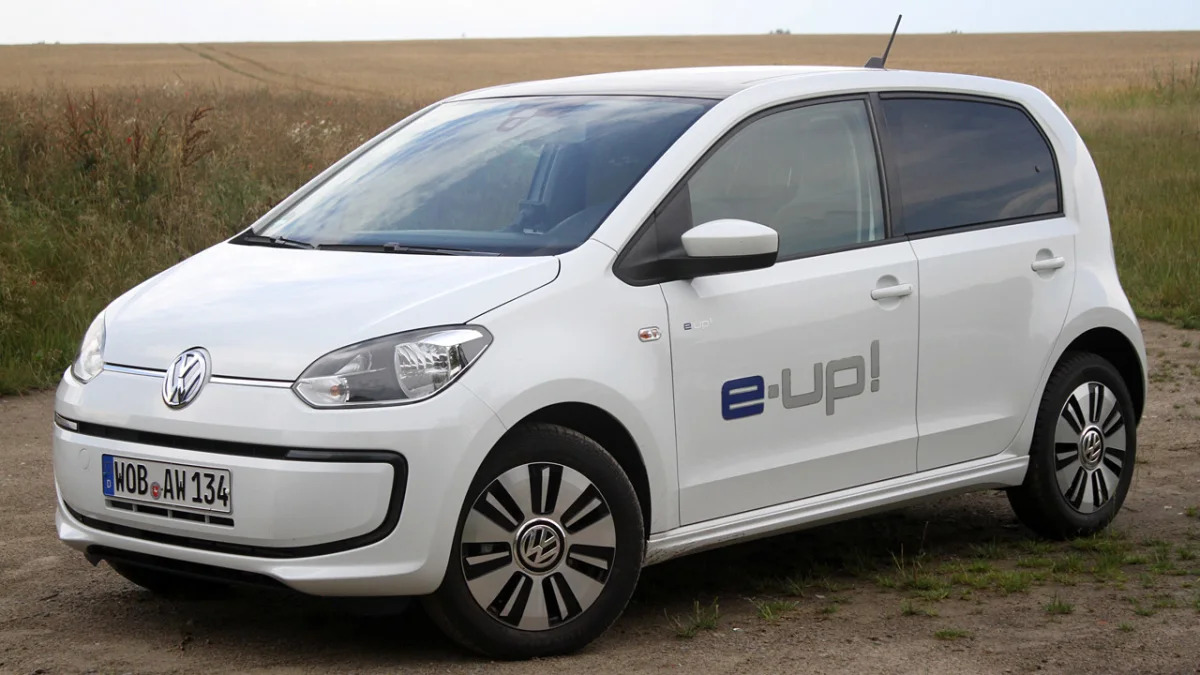-
Engine374-Volt, 18.7-kWh Battery
-
Power82 HP / 155 LB-FT
-
TransmissionSingle-Speed Auto
-
0-60 Time12.4 Seconds
-
Top Speed81 MPH
-
DrivetrainFront-Wheel Drive
-
Curb Weight2,506 LBS
-
Seating3+1
-
Cargo8.8 CU FT
-
MPG150-km Range (est.)
-
Base Price26,900 euros
Volkswagen sets targets that are entertainingly confident, its stated goal for electric mobility being "market leadership by 2018." The tiny e-Up! is the first round out of the electric cannon, one of 14 EV and hybrid models the company will put on the menu this year as it spreads the electric gospel throughout its range.
Driving Notes
Driving Notes
- A 506-pound lithium-ion battery housed under the floor between the axles has an 18.7 kilowatt-hour capacity, juicing an electric motor that provides 54 continuous horsepower and 82 peak hp alongside 155 foot-pounds of torque. That gets the 2,506-pound hatch from 0 to 62 miles per hour in 12.4 seconds, beating the quickest conventional Up! by nearly a second. Its top speed is 81 mph, and when you're not on acceleration runs, it has a range of up to 150 kilometers (93 miles).
- You can tell it apart from the standard Up! by the curved LED daytime running lamps in the lower front fascia, the model-specific 15-inch alloys, blue highlights on the emblems and the e-Up! logo on the hatch. Inside are light gray seat covers with blue stitching, and it's been stuffed with a bunch of options including a navigation system with e-specific software that includes features like range calculation.
- Two buttons in the cockpit are also giveaways: one marked "Eco" and "Eco+," the other with a picture of a plug. The plug button is used to tell the car to charge immediately. VW knows that some customers will prefer charging their car at night because that's when some energy suppliers in Europe offer heavy discounts for using electricity. Since charging can also be set using a smartphone, most people will just plug in the car and control things later from their touch screen.
- The Eco button is one of two different systems that provide eight options in frugality and extended range. The first is the three driving modes, Standard, Eco and Eco+. Eco mode caps maximum power at 67 hp and pull-away torque at 123 lb-ft, retards accelerator response, curbs air conditioning output and reduces top speed to 115 km/h (71 mph). Eco+ reduces max power to 54 hp and pull-away torque to 98 lb-ft, cuts back further on throttle response and shuts down the AC entirely. The top speed in Eco+ is 90 km/h (56 mph).
- The second system is regenerative braking with optional D1, D2 and D3 modes chosen by tapping the gear lever to the left or right, on top of regular Drive, in which regeneration happens only through rolling resistance. There's also B mode, accessed by pulling the gear lever back. Its regenerative action is strong enough to be used instead of the brake pedal under most circumstances. Each of the optional regen modes will activate the brake lights when in use.
- There's a dual-mode charge port called Combined Charging System (CCS) behind the filler flap that supports AC and DC charging. Plugged into a standard 2.3-kW European wall socket, a flat battery pack will be topped up in nine hours. Get VW's 3.6-kW charging box and that wait drops to six hours. Hook up to a public charging station with a DC supply of up to 40 kW, and a flat battery will be 80-percent juiced up in 30 minutes. Owners can keep tabs on the state of charge with the VW's Car-Net e-Remote app, which costs 101 euros – $133 USD – for 12 months.
- We scooted around VW's Wolfsburg home turf in one and found it a terrific little city car, a zippy arrow that adds yet more weight to the case for electric city cars. The Up! is already the best-selling supermini in Europe, and if you're not a long-haul commuter, the e-Up! and its more powerful, quicker and silent powertrain improves it.
- About the price, though. VW CEO Martin Winterkorn said, "To be a resounding success such an electric car must be affordable to a broad customer base as well as uncompromisingly practical in everyday driving." The e-Up! is practical, but its "broad customer base" will be those ready to lavish 26,900 euros on it – that's $35,500, more or less. Before options. Which could make for a rather narrow customer base. Like-for-like, it's around 12,000 euros (nearly $16,000) more than a conventional Up! – that's about $1,200 more than a Mercedes-Benz A-Class. Said another way, if you filled the tank of your gasoline Up! every week in Germany, it would take five years to claw back the difference.










Sign in to post
Please sign in to leave a comment.
Continue